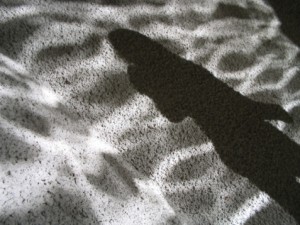Clothed in Clarity, Veiled in Light (Part 5)
By Asher Crispe: May 31, 2012: Category Decoding the Tradition, Inspirations
Approaching Modesty and Mystery in Kabbalah, Philosophy and Science
Elliot Wolfson’s Newly Uninspected Di/visions
—the rivers of your body
land of pulse-beats
to enter you
land of closed eyes
water with no thoughts
to enter me
entering your body
land of sleepless mirrors
land of waking water
in the sleeping night (42)
Octavio Paz
 Exploring the deep structures of transcendent or transpersonal intuition (a form of seeing) entails both a substantial reward and a risk. If used to found and maintain relationships, the value of self-effacement will have proven itself the ticket to the ‘beyond.’ On the other hand, the danger of not being seen, of leaving separation as simple negation and non-relation, bears consequences if abused in the realm of permanent loss of personal identity and lack of self-expression.
Exploring the deep structures of transcendent or transpersonal intuition (a form of seeing) entails both a substantial reward and a risk. If used to found and maintain relationships, the value of self-effacement will have proven itself the ticket to the ‘beyond.’ On the other hand, the danger of not being seen, of leaving separation as simple negation and non-relation, bears consequences if abused in the realm of permanent loss of personal identity and lack of self-expression.
To put it differently, does one elect to regulate one’s public appearances in their scope and intensity? Does one measure fitting roles and temper one’s spontaneity for the sake of sociality? Wherein lies the triumph of mystery to vanquish the ordinary? Likewise, must one be extraordinary simply in virtue of retaining a cloak of concealment as though only things and persons of significance are worth hiding?
Derrida, whose discursive writings have taken him to the four corners of the earth, also navigates the mystery of mystery: “Authentic mystery must remain mysterious, and we should approach it only by letting it be what it is in truth—veiled, withdrawn, dissimulated. Authentic dissimulation is inauthentically dissimulated by the violence of unveiling.” (43)
Levin acknowledges the unique place occupied by Levinas on these issues as well as Derrida’s assessment of it: “According to Jacques Derrida, Levinas was the first philosopher to give thought to ‘the ancient clandestine friendship between light and power, the ancient complicity between theoretical objectivity and technico-political possession.” (44)
While the other may be maintained in secrecy, the ascertaining of who will play the role of other would seem to require clarification. Here, I would argue, clarification can only amplify potential problems, that is: we must respect the requisite fuzziness and indeterminacy of whomever assumes the name “other”. Ambiguity caught between body and soul, female and male, carries the tension and responsibility of this question and concern. Subsequently, the myriad of textual support that situates otherness in the female court nonetheless resists complete reduction to the logic of the female sex. Sensitive to this pitfall in scholarship within the field of Kabbalah, Wolfson cautions: “It is no less a mistake to think of a single kabbalistic perspective on the topic of women as Other than it is to think of a singular attitude with respect to any of the essential ideas in theosophic kabbalah.” (45)
 Wolfson’s work in the past has dealt with many of the proof texts in the classical kabbalistic literature that should how: “the principle of femininity relates to the quality of division, separation, distinction, a principle that is represented imagistically as the membrane of the ether of the supernal wisdom that is hidden within the skull of the uppermost configurations of the divine anthropos.” Would this “wisdom” not be the very same wisdom granted to the modest in the book of Proverbs? Would this “wisdom” not be the same wisdom referenced in the Book of Modesty (sifra di-zeni’uta)? (46)
Wolfson’s work in the past has dealt with many of the proof texts in the classical kabbalistic literature that should how: “the principle of femininity relates to the quality of division, separation, distinction, a principle that is represented imagistically as the membrane of the ether of the supernal wisdom that is hidden within the skull of the uppermost configurations of the divine anthropos.” Would this “wisdom” not be the very same wisdom granted to the modest in the book of Proverbs? Would this “wisdom” not be the same wisdom referenced in the Book of Modesty (sifra di-zeni’uta)? (46)
The nature of this “distinctiveness” held by the feminine has been noticed in various psychoanalytic schools. Thus reading forwards in time Wolfson notes: “As Slavoj Žižek put it, the ‘feminine resistance to symbolic identification’ in Lacanian thought is not due to the ‘effect of a preexistent feminine substance opposing symbolization.’” (47)
Rejoining the discourse of Kabbalah, Wolfson nuances his position by detailing the connections forged in this line of thinking:
Here it is incumbent to note that in kabbalistic lore the genitals of a woman are also portrayed as hidden, an idea that is linked to the pietistic virtue of modesty promulgated in classical rabbinic literature, which demands of women that they conceal themselves from the phallic gaze, an attitude informed by a long-standing exegetical association of the feminine and interiority, which in turn fostered the symbolic representation of women in tropes that denote sheltering as well as the disproportional allocation of domestic responsibilities to the mother of the household. (48)
He furthermore enjoins us to be vary “on account of the kabbalists’ belief in the natural propensity of the female to be seductive, women are bridled with the virtue of modesty and implored to stay inside, to prepare the house for the entry of the man, and not flaunt a public display of sensuality or erotic enticement.” (49)
In doing so Wolfson opens a channel between the deep structures we’ve been visiting and the social and cultural norms that have been pushed into the margins of this essay. Balancing the account, he rightfully grants the relevance of modesty to the male—its applicability proscribed on both a conceptual and practical level—the outstanding instance being that of circumcision.
Beyond this association, however, the link between circumcision, secrecy, and concealment in kabbalistic tradition can be viewed as an embellishment of the rabbinic emphasis on the need to conceal the circumcised penis, an aspect of the etiquette of modesty (seni’ut) required of the Jewish male. Symbolically, for kabbalists, circumcision embodies the hermeneutical play of secrecy, which rests on the presumption that the wisdom that encompasses a hidden mystery (seni’uta) will be disclosed exclusively to the humble (senu’in), for they know the art of concealing the concealment in disclosing the disclosure. (50)
Consider the following paradox of the garment. Is it the garment that conceals or the garment that reveals? Or must we uphold a marriage of opposites: where to conceal is to reveal and to reveal is to conceal? Revelation and concealment prove to be more and less than opposites; they complement each other.
Divine wisdom is described concomitantly by the terms ‘disclosure’ (gilluy) and ‘attire’ (levush), terms that have diametrically opposing significations. To be disclosed is not to be attired, to be attired is not to be disclosed. Yet they are here joined together in the most pregnant expression: what is revealed is revealed through the garment, the gilluy is the levush. The primary function of the book, as may be gleaned from the description of the first book, is to uncover, to reveal, but this unveiling is achieved through the assumption of veils, the text disrobes by putting on clothes. The absent face of the Head that is not known, the primordial concealment, is adorned by the masks of Wisdom. Language, and in particular writing, strips the Infinite naked by covering it with the apparel of symbolic images and forms. (51)
Amongst his ruminations on “Occultation of the Feminine” Wolfson once again demonstrates this essential truth of language and interpretation as the garments of a ‘feminine text’ in the teachings of the Zohar:
In the final analysis, the hermeneutical position adopted in Zohar is such that there can be no unveiling of naked truth, for truth that is stark naked—divested of all appearance—is mere simulation. If the secret is the truth that is completely disrobed, then the secret is nothing to see. By contrast, the truth that is apparent is disclosed in and through the garment of its enclosure. The tension between the formless glory and the image endowed with form accounts for what may be called the erotics of dressing in zoharic literature, which is predicated on the paradox that nudity is the ultimate veil and the veil, the ultimate nudity: The naked body is the garment that obstructs the gaze, whereas the garment renders the body naked in its transparency. (52)
Echoes of this textual analogy as the literary body follow through as the superpositioning of the feminine within the loom of language. As Wolfson continues:
For he medieval Kabbalist, the concealed name is correlated with the masculine, and the revealed name, with the feminine. Consequently, the feminine is assigned the paradoxical role of representing that which cannot be represented. Representation in this case does not denote a re/presentation of that which is eclipsed from the field of vision, but the making present of that which forever alludes presence, the representation of the masculine absence that is known as absent only in its specul(riza)tion through the mirror of the feminine. (53)
Switching gears once again, we require another concept-in-translation to hammer home this sense of “masculine absence” known as such “through the mirror of the feminine.” Given that we have already introduced and treated (albeit in a limited way) the kabbalistic notions of tzimtzum (contraction/reduction/withdrawal) and shevirah (breaking/fragmentation), we need to add to these another central term in the vast landscape of Lurianic Kabbalah which is the idea of the tzimtzum creating a chalal or void/vacancy, and empty space (makom panui). (54)
 The term for this void suggests a relationship with the profane as an alternative to its literal meaning. Profanation is the result of the creating of an empty space, a void that is itself representative of a vessel. As an apparently ‘empty vessel,’ the feminine side of reality takes on the role of dressing the masculine side that has ‘concealed itself’ all the while acting within the limits of modesty. Overtones of this attitude can be discerned from within the phenomenological descriptions of modesty in Levinas’ writings which are executed with great mastery of both the philosophic tradition and the revelatory tradition of Jewish mysticism (which in his court also poses philosophic problems and makes philosophic arguments in decidedly non-philosophic language). With the term chalal, related in this passage as “profanation,” Levinas slips another kabbalistic concept into his stock of innovative philosophic terminology. Modesty remains “essentially hidden.”
The term for this void suggests a relationship with the profane as an alternative to its literal meaning. Profanation is the result of the creating of an empty space, a void that is itself representative of a vessel. As an apparently ‘empty vessel,’ the feminine side of reality takes on the role of dressing the masculine side that has ‘concealed itself’ all the while acting within the limits of modesty. Overtones of this attitude can be discerned from within the phenomenological descriptions of modesty in Levinas’ writings which are executed with great mastery of both the philosophic tradition and the revelatory tradition of Jewish mysticism (which in his court also poses philosophic problems and makes philosophic arguments in decidedly non-philosophic language). With the term chalal, related in this passage as “profanation,” Levinas slips another kabbalistic concept into his stock of innovative philosophic terminology. Modesty remains “essentially hidden.”
Ultramateriality does not designate a simple absence of the human in the piles of rocks and the sands of a lunar landscape, nor the materiality that outdoes itself, gaping under its rent forms, in ruins and wounds; it designates the exhibitionist nudity of an exorbitant presence coming as though from farther than the frankness of the face, already profaning and wholly profaned, as if it has forced the interdiction of a secret. The essentially hidden throws itself toward the light, without becoming signification. Not nothingness—but what is not yet. This unreality at the threshold of the real does not offer itself as a possible to be grasped; the clandestinity does not describe a gnoseological accident that occurs to a being. ‘Being not yet’ is not a this or that; clandestinity exhausts the essence of this non-essence. In the effrontery of its production this clandestinity avows a nocturnal life not equivalent to the simple inwardness of a solitary and inward life which would seek expression in order to overcome its repression. It refers to the modesty it has profaned without overcoming. The secret appears without appearing, not because it would appear half-way, or with reservations, or in confusion. The simultaneity of the clandestine and the exposed precisely defines profanation. It appears in equivocation. But it is profanation that permits equivocation—essentially erotic—and not the reverse. Modesty, insurmountable in love, constitutes its pathos. Immodesty, always dared in the presentation of wanton nudity, is not something added to an antecedent neutral perception, such as that of the doctor who examines the nudity of the patient. The mode in which erotic nudity is produced (is presented and is) delineates the original phenomena of immodesty and profanation. The moral perspectives they open are situated already in the singular dimension opened by this exorbitant exhibitionism, which is a production of being. (55)
Moreover, in another strange paradox, modesty, as opposed to extinguishing the erotic actually preserves and enhances it. Levinas presents the attraction of mystery that only modesty can sustain:
Voluptuosity, as profanation, discovers the hidden as hidden. An exceptional relation is thus accomplished in a conjecture which, for formal logic, would arise from contradiction: the discovered does not lose its mystery in discovery, the hidden is not disclosed, the night is not dispersed. The profanation-discovery abides in modesty, be it under the guise of immodesty: the clandestine uncovered does not acquire the status of the disclosed. To discover here means to violate, rather than to disclose a secret. A violation that does not recover from its own audacity—the shame of the profanation lowers the eyes that should have scrutinized the uncovered. (56)
 The patterns of modesty-immodesty in conjunction with the critique of vision and the quest for totality have long occupied Levinas. Some of his earliest formulations have continued to captivate. How much emphasis to place on his holding common cause with kabbalistic literature may never be proven or totality anchored in textual argument. Levinas lists an abundance of influences but one senses that he may not be entirely forthcoming, particularly in interviews such as the one recorded by Edith Wyschogrod in her Crossover Queries. (57)
The patterns of modesty-immodesty in conjunction with the critique of vision and the quest for totality have long occupied Levinas. Some of his earliest formulations have continued to captivate. How much emphasis to place on his holding common cause with kabbalistic literature may never be proven or totality anchored in textual argument. Levinas lists an abundance of influences but one senses that he may not be entirely forthcoming, particularly in interviews such as the one recorded by Edith Wyschogrod in her Crossover Queries. (57)
Likewise, with respect to the amount of relative weight to be assigned to the feminine in Levinas’ thought—where the distinction between the feminine and the female sex is intermingled as with the kabbalistic tradition. Armed with these concerns we read Levinas’ Time and the Other, where alterity, temporality, modesty, and the feminine are bound together.
The other as other is not here an object that becomes ours or becomes us; to the contrary, it withdraws into its mystery. Neither does this mystery of the feminine—the feminine: essentially other—refer to any romantic notions of the mysterious, unknown, or misunderstood women. (58)
As with the latter descriptions in Totality and Infinity, Levinas demonstrates that he already had the core themes worked out in this earlier sketch. He writes: “what matters to me in this notion of the feminine is not merely the unknowable, but a mode of being that consists in slipping away from the light” (59) and, along the same lines, “hiding is the way of existing of the feminine, and this fact of hiding is precisely modesty.” (60)
Once again, Wolfson upon detecting these sources and their import asserts:
A remarkably similar connection of eros, secrecy, modest, and the feminine, is found in traditional kabbalistic sources. Needless to say, in his strictly philosophical works, Levinas makes no explicit or implicit reference to the Jewish mystical tradition. My contention nevertheless is that he may have been influenced by the interrelatedness of these motifs in kabbalistic lore, and especially the zoharic tradition as it was mediated through the prism of Nefesh ha-Hayyim. (61)
Increasing our sense of his indebtedness to Kabbalah, Wolfson brings an uninspected dimension to this arena of Levinas studies. This new dimension proves to be the crux of our constellation of concepts surrounding the notion of modesty. Reverberating within this tightly packed and woven structure are the applications of antiquity to modernity and modernity to antiquity. Pondered with all their essential ambiguity, these terms and conditions may ultimately rest easier if left unresolved. Levinas reenergizes the mundane notion of modesty. He even elevates its meaning as it serves as a valid form of critique of philosophy and science, of sociology and psychology. He inspires a wider conversation about the feminine of history and today and its associated mystery:
The transcendence of the feminine consists in withdrawing elsewhere, which is a movement opposed to the movement of consciousness. But this does not make it unconscious or subconscious, and I see no other possibility that to call it mystery. (62)
Wolfson, who has built out these structures to the next level, will compel us to grapple with the new quantum logic of “immodesty, [which] on this score, is the unabashed and complete disclosure, whereas modesty presupposes the disclosure of the hidden as concurrently hidden and disclosed” (63) on ever new horizons.
41 Ibid. p.216.
42 “Blanco,” Collected Poems. P.319.
The Gift of Death, p.37. Note also his long ‘informal’ work titled The Taste for the Secret.
44 The Philosopher’s Gaze, p.246 following Derrida’s landmark essay on Levinas “Violence and Metaphysics” in Writing and Difference, p.91.
45 “Woman—The Feminine as Other in Theosophic Kabbalah” in The Other in Jewish Thought and History, p.168.
46 Wolfson, in the course of a discussion of Luzzatto. From his Language, Eros, Being, pp.76-77. See also note 197 p.453 where he links these ideas to the “Book of Modesty” section in Zohar II 177a.
47 Ibid. p.130. See note 138 (p.483) where Wolfson weaves the phraseology of Žižek from his Tarrying with the Negative, pp.57-58.
48 Ibid. pp.134-135.
49 Ibid. p.134.
50 Ibid. p.135.
51 “From Sealed Book,” p.156.
52 “Occultation of the Feminine and the Body of Secrecy” in Rending the Veil, p.116.
53 Ibid. p.117.
54 This term figures centrally in such texts as Etz Chaim Sha’ar Igulim v’Yosher chapter 2.
55 Totality and Infinity, pp.256-257.
56 Ibid. p.260.
57 Pp.283-297.
58 Time and the Other, P.86.
59 Ibid. p.87.
60 Ibid. p.87
61 “Secrecy, Modesty and the Feminine”, p.209.
62 Time and the Other, p.88.
63 “Secrecy, Modesty and the Feminine”, p.209.























;)
;)
;)
;)
;)
;)
;)
;)
;)
;)
